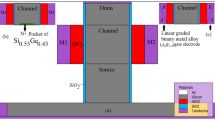Abstract
This paper proposes a novel linear graded binary metal alloy PαQ1-α gate electrode and middle N+ pocket of Si0.5Ge0.5 Vertical-TFET (LGN-VTFET) device structure. The device is gradually developed by considering initially the impact of middle N+ pocket of low band Si0.5Ge0.5 material at the channel side and then utilizing the linear graded electrodes work function of binary metal alloy instead of single metal work function. The designed device exhibits fascinating performance enhancement, as it shows 2 orders ON-current improvement over the single work function VTFET (SG-VTFET) keeping the same OFF-current and also, it renders 7 mV/Dec Sub-threshold Slope (SS), which is 79% lower than (SG-VTFET). Inclusion of N+ pocket of Si0.5Ge0.5 causes narrower tunneling band space and hence results in a high tunneling rate. Implementation of the linear graded work function of binary metal alloys causes abrupt decay in the tunneling rate unlike the gradual decay tunneling rate of single work function from the source channel interface towards the channel and in turns, offers steep sub-threshold Slope (SS). This device with a lower SS improves the transistor’s switching and encourages its applicability in high-speed circuits.
Similar content being viewed by others
References
Mookerjea S, Krishnan R, Datta S, Narayanan V (2009). IEEE Trans Electron Devices 56:2092. https://doi.org/10.1109/TED.2009.2026516
Ahish S, Sharma D, Kumar YBN, Vasantha MH (2015). IEEE Trans Electron Devices 63:288. https://doi.org/10.1109/TED.2015.2503141
Boucart K, Ionescu AM (2007). IEEE Trans Electron Devices 54:1725. https://doi.org/10.1109/TED.2007.899389
Settino F, Lanuzza M, Strangio S, Crupi F, Palestri P, Esseni D, Selmi L (2017). IEEE Trans Electron Devices 64:2736. https://doi.org/10.1109/TED.2017.2689746
Kumar N, Mushtaq U, Amin SI, Anand S (2019). Superlattices and Microstructures 125:356. https://doi.org/10.1016/j.spmi.2018.09.012
Beneventi GB, Gnani E, Gnudi A, Reggiani S, Baccarani G (2014). IEEE Trans Electron Devices 61:776. https://doi.org/10.1109/TED.2014.2298212
Kumar MJ, Janardhanan S (2013). IEEE Trans Electron Devices 60:3285. https://doi.org/10.1109/TED.2013.2276888
Bagga N, Dasgupta S (2017). IEEE Trans Electron Devices 64:606. https://doi.org/10.1109/TED.2017.2783911
Zhang JH (2016) STMicroelectronics lnc, U.S. Patent 9,385,195. US9385195B1
Tan C, Chen J, Wu XJ, Zhang H (2018). Nat Rev Mat 3:1. https://doi.org/10.1038/natrevmats.2017.89
Gandhi R, Chen Z, Singh N, Banerjee K, Lee S (2011). IEEE Electron Device Lett 32:1504. https://doi.org/10.1109/LED.2011.2165331
Deb S, Singh NB, Islam N, Sarkar SK (2011). IEEE Trans Nanotechnol 11:472. https://doi.org/10.1109/TNANO.2011.2177669
Dash S and Mishra GP (2020) J Comp Electron. 1:. https://doi.org/10.1007/s10825-020-01465-x
Jhaveri R, Nagavarapu V, Woo JC (2010). IEEE Trans Electron Devices 58:80. https://doi.org/10.1109/TED.2010.2089525
Sadek A, Ismail K, Armstrong MA, Antoniadis DA, Stern F (1996). IEEE Trans Electron Dev 43:1224. https://doi.org/10.1109/16.506773
Haddara YM, Ashburn P and Bagnall DM (2017) Springer Handbook of Electronic and Photonic Materials 1–1. DOI : https://doi.org/10.1007/978-3-319-48933-9_22
Haensch W, Nowak EJ, Dennard RH, Solomon PM, Bryant A, Dokumaci OH, Kumar A, Wang X, Johnson JB, Fischetti MV (2006) Silicon CMOS devices beyond scaling. IBM J Res Dev 50:339–361. https://doi.org/10.1147/rd.504.0339
Huang, H.S., Huang, P.R., Wang, M.C., Chen, S.Y., Wang, S.J., Chou, C.C., Huang, L.S. and Wang, W.L., (2019). https://doi.org/10.20944/preprints201902.0093.v1
Venkatesh, M., Suguna, M. and Balamurugan, N.B., Silicon L, (2020). https://doi.org/10.1007/s12633-020-00385-6
Venkatesh M, Suguna M, Balamurugan NB (2019) Subthreshold Performance Analysis of Germanium Source Dual Halo Dual Dielectric Triple Material Surrounding Gate Tunnel Field Effect Transistor for Ultra Low Power Applications. J Electron Mater 48:6724–6734. https://doi.org/10.1007/s11664-019-07492-0
Dash DK, Saha P, Banerjee P, Sarkar SK (2018) International conference on computing. Power Comm Technol (GUCON) 212. https://doi.org/10.1109/GUCON.2018.8675072
Tsui BY, Huang CF (2003) Wide range work function modulation of binary alloys for MOSFET application. IEEE Electron Device Lett 24:153–155. https://doi.org/10.1109/LED.2003.809528
Young KK (1989) Short-channel effect in fully depleted SOI MOSFETs. IEEE Trans Electron Devices 36:399–402. https://doi.org/10.1109/16.19942
Ishii R, Matsumura K, Sakai A, Sakata T (2001). Appl Surface Sci 169:658. https://doi.org/10.1016/S0169-4332(00)00807-2
Nigam K, Kondekar P, Sharma D (2016) High frequency performance of dual metal gate vertical tunnel field effect transistor based on work function engineering. Micro Nano Lett 11:319–322. https://doi.org/10.1049/mnl.2015.0526
Manna B, Sarkhel S, Islam N, Sarkar S, Sarkar SK (2012) Spatial Composition Grading of Binary Metal Alloy Gate Electrode for Short-Channel SOI/SON MOSFET Application. IEEE Trans Electron Devices 59:3280–3287. https://doi.org/10.1109/TED.2012.2220143
Kumar, P., Gupta, M. and Singh, K., 2019. Performance evaluation of transition metal Dichalcogenides based steep subthreshold slope tunnel field effect transistor. Silicon, pp.1-8
Kumar N, Amin SI, Anand S (2020) Design and performance optimization of novel Core–Shell Dopingless GAA-nanotube TFET with Si 0.5 Ge 0.5-based source. IEEE Trans Electron Devices 67(3):789–795
Kanungo S, Chattopadhyay S, Gupta PS, Sinha K, Rahaman H (2016) Study and Analysis of the Effects of SiGe Source and Pocket-Doped Channel on Sensing Performance of Dielectrically Modulated Tunnel FET-Based Biosensors. IEEE Trans Electron Devices 63:2589–2596. https://doi.org/10.1109/TED.2016.2556081
Author information
Authors and Affiliations
Corresponding author
Additional information
Publisher’s Note
Springer Nature remains neutral with regard to jurisdictional claims in published maps and institutional affiliations.
Rights and permissions
About this article
Cite this article
Singh, J., Wadhawa, G. Novel Linear Graded Binary Metal Alloy PαQ1-α Gate Electrode and Middle N+ Pocket Si0.5Ge0.5 Vertical TFET for High Performance. Silicon 13, 2137–2144 (2021). https://doi.org/10.1007/s12633-020-00654-4
Received:
Accepted:
Published:
Issue Date:
DOI: https://doi.org/10.1007/s12633-020-00654-4



